How does latent semantic indexing have an effect on search engine optimisation?
In search engine optimization, you will learn a lot about keywords and their effects on your content rankings. However, you don't hear that much about Latent Semantic Indexing (LSI) and how it affects search engine optimization.
If you're unfamiliar with the term, Webopedia.com defines LSI as "an algorithm used by search engines to determine what a page is about without specifically matching any query text". Further explanations can be found below.
When used effectively, LSI can give your rankings a significant boost – and using it in your content may be easier than it sounds.
First, let's explain what LSI keywords are and why they are important.
What are LSI Keywords?
Put simply, LSI keywords are terms semantically related to your topic. Any LSI keyword, phrase, or phrase that you use is relevant to the main keyword that you are targeting. However, they are not always synonyms. LSI also looks for ideas that are often found in conjunction with your primary keywords.
Including LSI keywords in your content will help Google better understand the theme of the website by giving the context. LSI also makes it easier for Google to index your content and may give your website better visibility.
Here is an example of LSI keywords.
If we use "cake recipe" as a search term, we see the following:
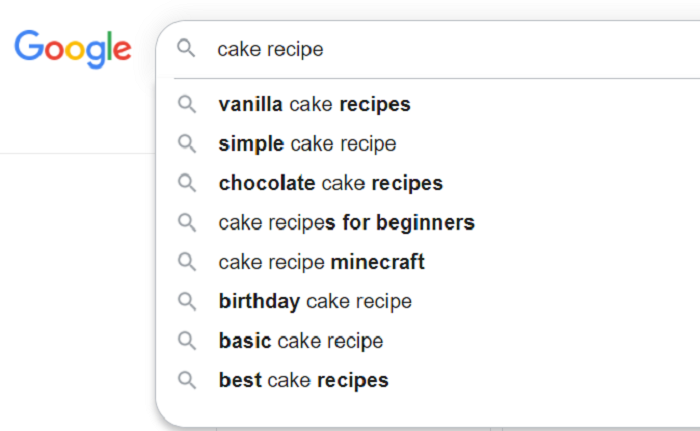
As you will find, Google's automatic suggestion offers several additional search terms in bold. LSI keywords – these related words and phrases – can help you get a better idea of what consumers are looking for and develop new ideas for content.
The result? The ability to rank for multiple keywords and attract a larger audience
Why are LSI Keywords important?
You've probably all heard of "keyword stuffing". Not so long ago, all it took to get a website highly rated by search engines was: Repeat your keywords over and over again.
Back then, some marketers liberally distributed their target keywords throughout text, headings, and meta-descriptions – basically everywhere. While this effectively helped get it ranked highly by search engines, this approach had drawbacks:
- The content was often not relevant.
- The text was generally of poor quality.
- The seeker's questions were not answered.
Machine learning and AI have made search engines smarter. For Google, this meant the introduction of the Hummingbird algorithm. Hummingbird combined new and old technology to produce smarter results and highlight quality content over keyword quantity.
In short, Hummingbird doesn't analyze specific SEO keywords. Instead, the context of the searcher's questions is examined, and relevance and intent are examined.
As Google explains, while keywords are still of the utmost importance, they are also used by their system
… aggregated and anonymized interaction data to assess whether search results are relevant to queries. We convert this data into signals that our machine-learned systems can use to better assess the relevance.
Kolibri also uses more long-tail keywords.
Using LSI keywords throughout your SEO strategy is critical because they:
- Enable improved content quality by using related search terms
- Provide relevance to your content without overusing keywords
- Activate better visibility of your content
- Offer more ranking opportunities as LSI keywords allow you to rank related terms rather than just your keywords
- Limit your chances of getting Google penalties for frequent keyword use.
How to Find LSI Keywords
There are several ways that you can find multiple ranked keywords. Here are a few different ways you can do this on Google.
1. Words in bold in SERP results
If you search on Google, you can find related terms in the SERP results. Google will highlight these terms in bold. For example, when we use the term "camping gear" we get the following suggestions:
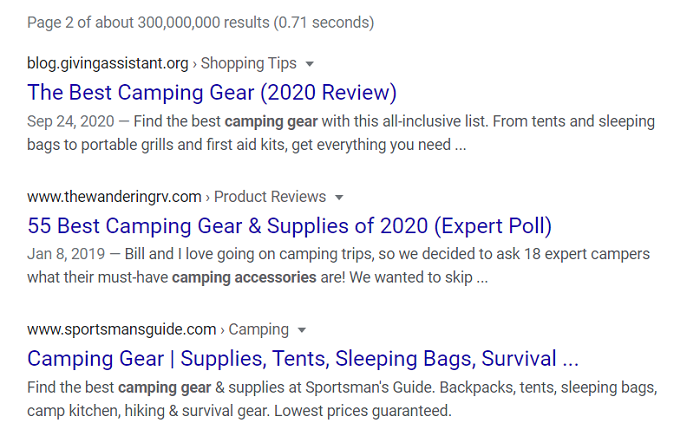
As you can see, the specific keywords as well as the similar phrase "camping accessories" were found. If you look further, you will likely see words such as "supplies", "campground" and "warehouse" too.
As a bonus The SERP results make it easy to see the LSI keywords that your competitors are targeting.
2. Using Google Autocomplete
If you use Google you know that every time you type a search term, it creates a list of related words. For example, if we use "hiking" we get the following suggestions:
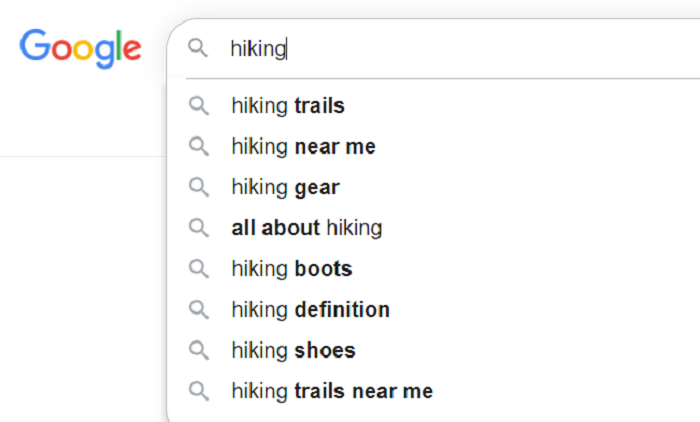
3. Topic modeling
Topic modeling is an approach that is widely used by content marketers. This makes possible:
- More focused content
- Clear direction for your articles, website copy, etc.
- More likely to create content
As with LSI, related words and phrases are used in topic modeling. The Content Marketing Institute explains, “Words and phrases are related, and the idea behind topic modeling is to discover those relationships. When crawling your content, search engines look not just for specific words, but for words with related meanings. "
They go on to explain how to structure your content to use topic modeling effectively:
- You should have your target keywords in your primary header, in the first paragraph, and as often as possible.
- Your sub-headings should be relevant, but not necessarily include the keywords.
- Ideas that are related but not "on the nose" should be included in the text. They still help with ranking.
4. Search Google Search for related searches
If you scroll to the bottom of the Google search page, you'll see a list of related searches. If we use the same example as above, we get:
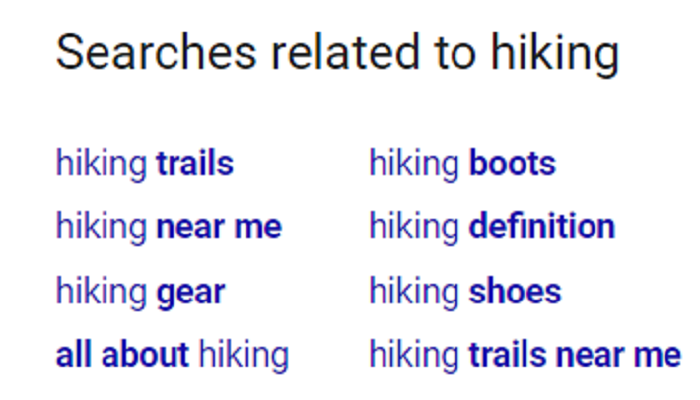
These are alternative terms that you can use in your work to improve your SEO results. You can also create brand new content like blog posts that specifically address these searches.
5. People ask too
Another useful Google tool is the People Too feature. A list of questions is displayed for which to search for answers.
Let's look at "Hiking" again. If you search for it and look at "People Also Ask," you might see:
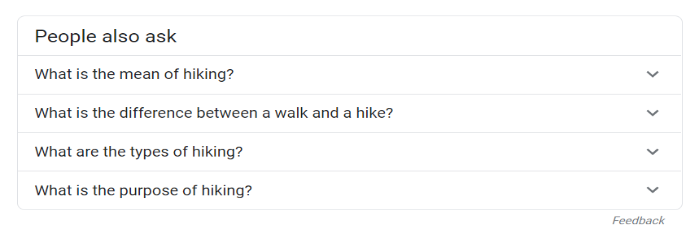
To improve your content, you should target at least some of it to popular queries. You can ask these questions, especially with headings, in your content. This will give readers the answers they are looking for.
6. Google Trends
Google Trends is a service that Google offers so that you can view some of the website's most popular searches and their relevant data.
When you go to trends.google.com you will see a search option. Enter your keyword in this field.
For our purposes, let's look for "apple". The following screenshot is shown when you scroll to the bottom of the results page.

As you will see above, it will generate a list of related topics and queries suitable for LSI keywords.
If you were hoping for apple, the fruit, rather than the various other options, you may need to change your keyword so your intention becomes more obvious.
Tools to find LSI keywords
There are many other easy-to-use tools for finding LSI keywords. Here are two examples.
Ubersuggest
Enter your search term, click "Search" and my Ubersuggest tool will generate:
- Domain overview
- Top SEO Pages
- Keyword suggestions
- Content ideas
- Backlink data
In the following example we used "Yoga" as a search term. If you just scroll down a little after searching, you'll see a list of suggested keywords.

As you can see, you won't just be shown the suggested keywords.
You can also see related keywords, frequently searched questions about the keyword, keywords with prepositions, and comparisons such as yoga and pilates. To find out all the details, open a free account.
LSI graph
According to the LSI Graph, according to the tag line, you can “generate LSI keywords that Google LOVES”.
Some key features are:
- Traffic and competition analysis
- Unlimited high quality LSI keywords
- Find the top ranked content in every niche
First go to LSIgraph.com, enter your key phrase, click "Generate". The website will create a list of LSI keywords and best performing content.

We used "yoga" again for our keyword search.
Note: This information is displayed in side-by-side columns when you use the site. We have split them into two images so that they are more visible.
This is the left column. It shows you LSI keywords related to “yoga” with information on trends, volume, CPC and more.
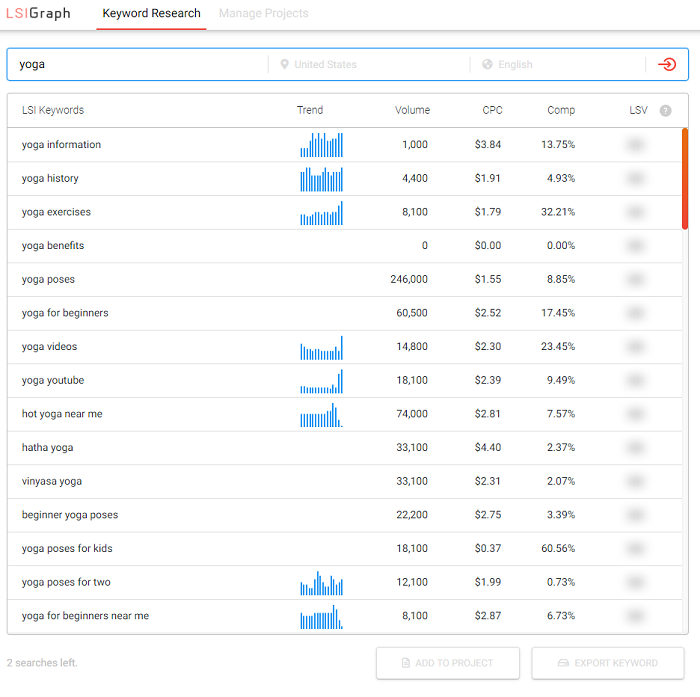
This second picture, the right column, shows you the most powerful content on the topic of "Yoga".
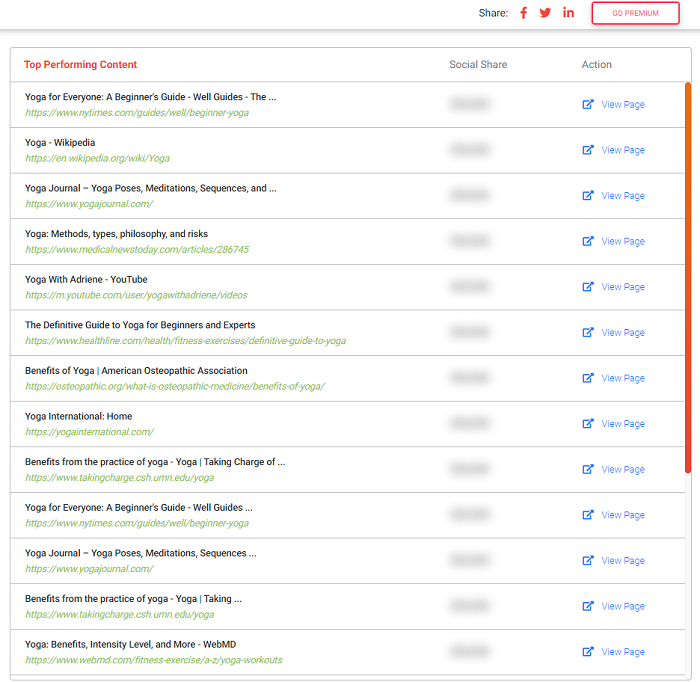
The basic version is free, but you can upgrade to premium from $ 27 per month.
Other tools to consider
While these are great tools, there are others that you can check out. Some good options are:
If you are a WordPress user, you can access various other plugins to further aid your SEO efforts.
Use of LSI keywords
Now that you understand the meanings of LSI keywords and how to use various relevant tools, here are some basic guidelines for using your LSI keywords in your content:
- Focus on topics, not just keywords.
- Decide on the primary and core keywords that you are targeting.
- The LSI keywords you use should support and be relevant to your primary target keywords.
- Before writing, make a list of LSI keywords. Many of the related terms appear organically in your content. When you finish writing, add the remaining target terms.
- When creating text, use LSI keywords in the same way as normal keywords – within the text of course.
- Make sure everything you write is high quality and useful to your readers.
If you want to create your content, you can use LSI keywords on your website, including:
- Pages and blog articles
- Headings, page titles and images
- Anchor and alternative text
- H2 and H3 subheadings and other HTML
- URLs and meta tags
- Meta descriptions
- Conclusions
Update old content
Don't just focus on creating new content, give previous content an SEO boost by adding LSI keywords.
That way, you have another way to discover your older material from Google and in front of an eager audience.
Optimize images
Revise old pictures by tweaking them with LSI keywords to improve their visibility. You can do this by simply renaming the images with the LSI keywords you selected. Don't forget the alternative text.
Using LSI Keywords in Metadata
Get your content noticed on Google by including LSI keywords in your metadata descriptions, image descriptions and meta tags. Dot Com Infoway suggests using both your target keyword and an LSI keyword in your meta descriptions to improve search results and improve your ranking.
Using LSI Keywords in HTML
Add LSI keywords to your heading, picture, and title tags. Again, you want to use words that seem natural to readers and search engines alike.
Use LSI Keywords in Paragraph Text
Include your target LSI keywords in the first paragraphs of your articles and in your posts. For natural-sounding content, make sure your keyword use is organic and spread throughout the article.
In addition:
- Use related topics as sub-headings and create paragraphs around them.
- Add an LSI keyword to your conclusion.
- In your articles, ask questions that answer searchers' questions.
Use LSI keywords in anchor text
Add variety to your anchor text with semantic keywords so search engines can better understand your content.
Conclusion
Search engines like Google have become more sophisticated over the years, using machine learning and AI to understand entire pages and their topics, rather than just targeting keywords.
The days of keyword filling and poor quality content are long gone. To improve your content rankings, you need to develop relevant, helpful, and high quality material.
Include LSI keywords in your strategy to increase the likelihood of wider visibility. Don't forget to revisit old parts in the process.
Did you use LSI keywords or LSI tools as part of your SEO strategy?
